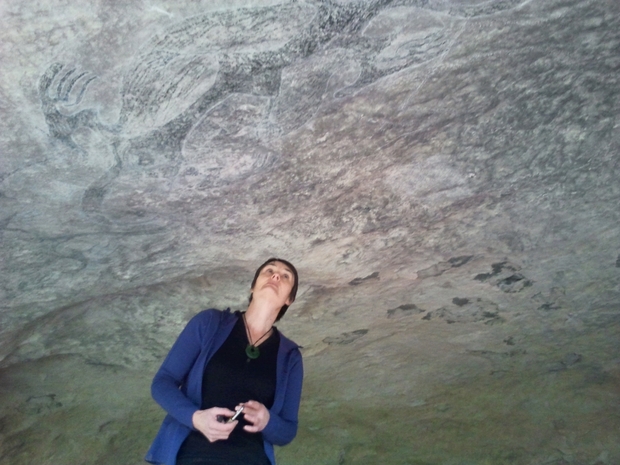Our Changing World for Thursday 2 January 2014
Welcome to Summer Science, a special edition of highlights from 2013
On This Programme
Great White Butterfly Eradication

Great white butterflies lay large yellow eggs in clusters, have large green caterpillars that feed in groups, and the adults are twice the size of the small white cabbage butterfly (images from DOC)
The great white butterfly, also known as the large white, is the big cousin of the familiar small white cabbage butterfly. It was first detected in Nelson in 2010, when the Ministry for Primary Industries decided it would be too hard to control, based on how quickly the small white cabbage butterfly had established. However, the great white butterfly established more slowly than expected, so a year ago a massive multi-agency eradication attempt swung into action, funded and led by the Department of Conservation. The great white butterfly has been declared an unwanted organism in New Zealand under the Biosecurity Act 1993.
Great white butterfly caterpillars eat brassicas (such as broccoli, cabbage, and cattle feed such as kale), along with nasturtium and honesty, and DOC is concerned that they could threaten small native cresses in the genus Lepidium, some of which are already rare. To date the butterfly has been found in Nelson city as far as Glenduan and Richmond, but have not yet been detected outside the city boundary.
Last year (2012-13) project leader Richard Toft from Entecol and his team made over 25,000 visits to houses and gardens in and around Nelson, and Alison Ballance joins him to find out is involved.
This summer (2013-14) DoC is running the eradication campaign. If Nelson and Tasman residents find the great white butterfly, caterpillars or pupae they are asked to destroy them and then phone the MPI hotline 0800 80 99 66.
Wild Birds in the Dunedin Botanic Gardens - Student Podcast
Students from the Centre for Science Communication at the University of Otago learn about the many varied aspects of science communication, including making an audio podcast, and as part of Summer Science we are playing four of the student podcasts. This week's podcast is by Jonas Goodwin, who heads to the Dunedin Botanic Gardens to meet curator Alan Matchett, and hear about the challenge of having wild birds such as kaka, shags and ducks living in the gardens.
Māori Rock Art

Ngāi Tahu Māori Rock Art Trust curator Amanda Symon inspects a drawing on a limestone wall that would have provided shelter for a large group of people (images: V Meduna).
Throughout South Canterbury and North Otago, some limestone outcrops are covered in black and red drawings of moa, the giant Haast eagle, birdmen, taniwha and other mythical creatures. Almost 600 sites of ancient Māori rock art have been identified, and new ones are still being discovered. In the 1990s, Ngāi Tahu, the iwi which holds kaitiakitanga, established the South Island Māori Rock Art Project, or SIMRAP, to record as much rock art as possible within the South Island. Collectively, these drawings provide a record of Māori occupation, in a continuum that extends from moa-hunting to early European contact, depicted in drawings of European sailing ships and horses.
Māori rock art is the youngest expression of a tradition that goes back more than 40,000 years in Australia and Europe, and it have attracted the interest of French archaeologist and cave art authority, Jean Clottes, who visited last year to establish an exchange programme to allow young Māori researchers to travel to France to see the rock art collections there.
In this features, Veronika Meduna visits the Te Ana Māori Rock Art Centre and then joins Ngāi Tahu Māori Rock Art Trust curator Amanda Symon for a tour to see the diversity of sites and drawing styles. Jean Clottes shares his impressions from his first visit to see the ancient drawings.

The valley which features the Cave of the Taniwha, and Yann-PIerre Montelle at work on one of the taniwha drawings.
Chemistry Show

A science magic show with Dave Warren at St Gerard’s School in Alexandra (images: Angela Moeke)
Science ‘magic’ shows, also known as chemistry shows, are a chance to excite students about chemistry and show them some fun science. Dave Warren from the University of Otago chemistry outreach programme presents chemistry shows in schools, along with experienced university students who get to improve their communication skills. Magic shows are quite often used as an initial visit to generate pupils’ interest before they experience ongoing science activities at school.
Dunedin North Intermediate School has a strong association with Dave Warren and has been conducting science activities at the school for a number of years. One of the aims of the outreach programme is that students will end up pursuing chemistry or scientific studies at the University of Otago.
Ruth Beran experiences the excitement of a science ‘magic’ show, presented to a packed hall of Year 7 students by Dave Warren, Masters student Ruth Warren and research assistant Marina Roxburgh. Ross Leach, principal at Dunedin North Intermediate School, and Year 8 teacher Kara Whaley, explain why chemistry shows are important for their students.
Next Week in Summer Science
Trout eradication at Zealandia, writing and health, the CSI effect, and red-billed gulls at Kaikoura.